‘Fashioning Modernity’ examines changing Nigerian identity
February 8, 2019
 Ann Basu
Ann BasuVisitors are packed in the Becker Gallery, chatter filling the air as community members and students alike wait in anticipation to see the new exhibition, “Fashioning Modernity: Art and Independence Among Yorubas in Nigeria,” on display at the Bowdoin College Museum of Art (BCMA).
The exhibit highlights the evolution of Yoruba traditions in the postcolonial moment by focusing on the production and significance of textiles.
“This is a moment at which this nation, Nigeria, [is] being forced to think about who they are as a nation now that they’re no longer under British rule. And that’s being expressed through these innovative crafts and arts,” said Kinaya Hassane ’19, who is among the group of students who helped Allison Martino, Andrew W. Mellon Postdoctoral Fellow in Africana Studies, curate the exhibition.
After taking Martino’s course last fall titled “African Art and Visual Culture,” four of the students formed a curatorial team, devoting their own time to organize the exhibit. Martino served only an advisory role, allowing the students to take charge of the curation.
The artifacts were donated by Brunswick resident Dorothy A. Hassfeld, one of the first members of the Peace Corps to go to Nigeria in the 1960s. A decade after her first visit, Hassfeld returned, camera in hand, to photograph what she saw of the nation. Her photographs are displayed alongside the cloths that she donated.
“Once [the group] decided [on] objects and [what] our guiding inquiry would be, we would spend time thinking about the layout and how we would tell the narrative to viewers … and [we] spent time looking at how Africa had been represented in different kinds of museums,” said Martino.
To visitors, the exhibition’s aesthetic stands out from the rest of the museum space. Cloth drapes freely on opposite sides of the exhibition room and in the back, stand mannequins adorned with more cloth.
The difference, Hassane said, are intentional.
“We thought about the history of these ‘cabinets of curiosities’ where [objects are] placed in these glass boxes and you’re separated from them,” said Hassane. “You’re not really seeing them in the original context that they were meant to be seen. By de-contextualizing them, they lose a lot of autonomy and power,” said Hassane.
By creating a more animated space to display the pieces in this collection, the student-curators hope to remove the distant gaze that Americans are so used to in Western museums.
“Africa is subject to a lot of misperception from people who may not have direct contact or experience with the continent,” Hassane said.
This mediated relationship, Martino said, stands in the way of a deeper understanding of the dynamic, evolving nature of Yoruban textile traditions. The team chose a title that reflects these curatorial choices.
“The first part of the title ‘Fashioning Modernity’ relates to our interest in considering African Textiles as innovative practices that are changing and evolving for many Yoruba people,” Martino said.
Inextricably linked to identity, cloth evolved with Yoruba culture during Nigeria’s independence period in the 1960s.
Aso oke, a traditional cloth that’s worn in important events like weddings, embodies this dynamism. In post-colonial Nigeria, it has become a part of the fashion and cultural industry, said Harrison Dunne-Polite ’19, another student-curator.
Other types of cloth on display in the exhibition include factory-printed cloth, which was once produced in Indonesia, the Netherlands and England for African consumption. Once production shifted to Africa, local identity took over as a key part of the aesthetics.
“[Fabric] pertains to the larger theme and really encapsulates the idea of this traditional object signifying ideas that look forward into the future,” Hassane said.
“Fashioning Modernity: Art and Independence among Yorubas in Nigeria” is on view at the BCMA until March 17.

Comments
Before submitting a comment, please review our comment policy. Some key points from the policy: